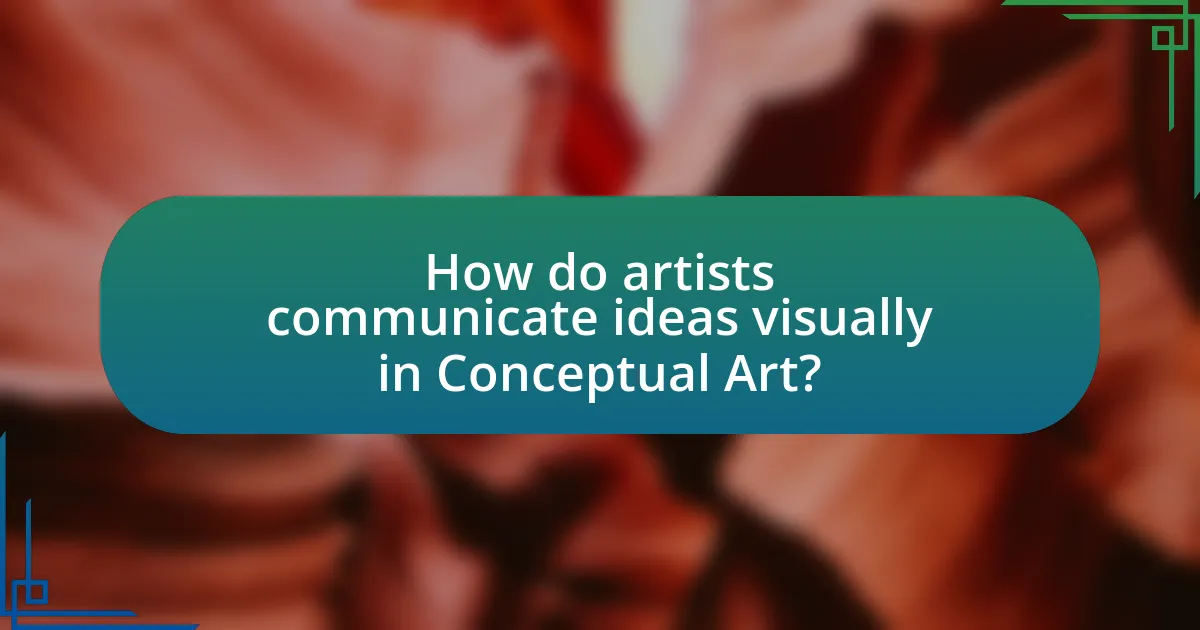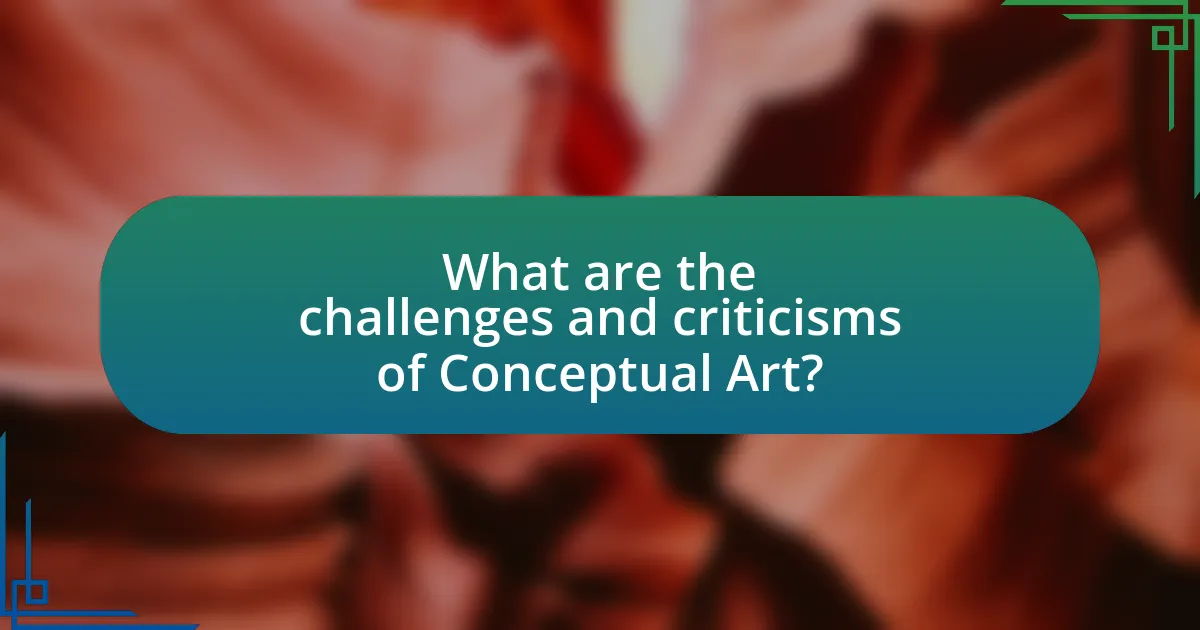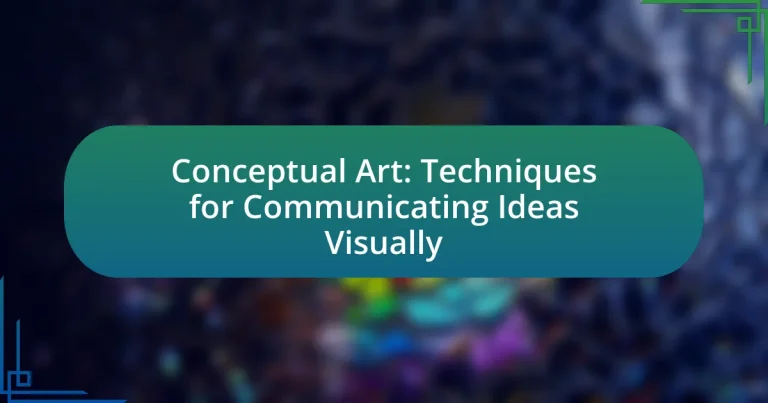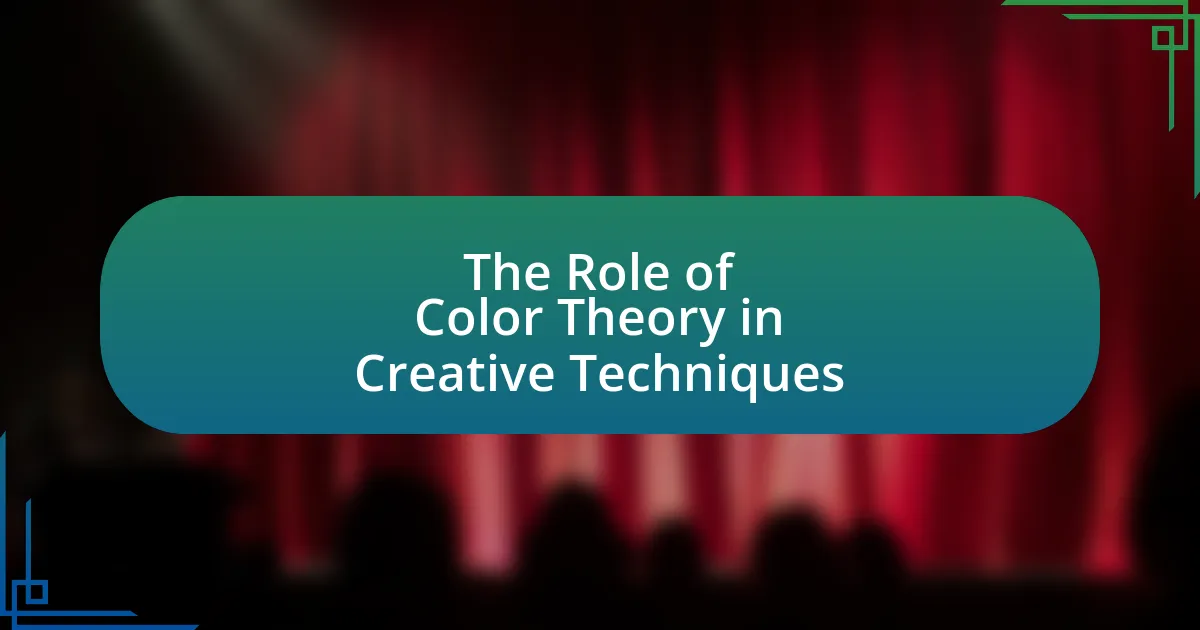Conceptual Art is an art movement that prioritizes the idea or concept behind the artwork over traditional aesthetic and material concerns. Emerging in the 1960s, it challenges conventional definitions of art by asserting that any medium can be used to convey ideas, emphasizing intellectual engagement and viewer interpretation. The article explores the key characteristics of Conceptual Art, its historical context, and the influence of earlier movements like Dada and Surrealism. It also examines the techniques artists use, such as text, performance, and installation, to communicate complex concepts visually, while addressing the challenges and criticisms faced by this art form.

What is Conceptual Art?
Conceptual art is an art movement where the concept or idea behind the artwork takes precedence over traditional aesthetic and material concerns. This form of art emerged in the 1960s and is characterized by the belief that the essence of art lies in the idea rather than the physical object itself. Artists such as Sol LeWitt and Marcel Duchamp exemplified this approach, emphasizing that the thought process and the viewer’s interpretation are integral to the artwork’s meaning. The movement challenges conventional definitions of art, asserting that any medium can be used to convey ideas, thus broadening the scope of artistic expression.
How does Conceptual Art differ from traditional art forms?
Conceptual Art differs from traditional art forms primarily in its emphasis on ideas over aesthetic or technical execution. While traditional art often focuses on visual appeal, craftsmanship, and representation, Conceptual Art prioritizes the concept or message behind the work, often using unconventional materials and methods to convey its meaning. For instance, Marcel Duchamp’s “Fountain,” a urinal presented as art, challenges the notion of what constitutes art by focusing on the idea rather than the object itself. This shift in focus reflects a broader movement in the art world that emerged in the 1960s, where the intellectual engagement of the viewer became paramount, distinguishing Conceptual Art from its traditional counterparts.
What are the key characteristics of Conceptual Art?
Conceptual Art is characterized primarily by the idea or concept behind the artwork, rather than the aesthetic or material aspects. This form of art emphasizes the notion that the concept is the most crucial element, often prioritizing intellectual engagement over traditional artistic techniques. For instance, artists like Sol LeWitt and Marcel Duchamp exemplified this by creating works that challenged conventional definitions of art, focusing on the thought process and the viewer’s interpretation. Additionally, Conceptual Art often employs various media, including text, installations, and performance, to convey its messages, further illustrating that the medium serves the idea rather than the other way around.
Why is the idea more important than the aesthetic in Conceptual Art?
The idea is more important than the aesthetic in Conceptual Art because the primary focus of this movement is to convey a concept or message rather than to create a visually pleasing object. Conceptual artists, such as Sol LeWitt and Marcel Duchamp, emphasize that the thought process behind the artwork is what holds significance, often prioritizing intellectual engagement over traditional artistic beauty. This approach is evident in Duchamp’s “Fountain,” where the selection of a urinal as art challenges conventional definitions and provokes critical thought about art itself. Thus, the validity of Conceptual Art lies in its ability to stimulate discussion and reflection on ideas, making the concept the central element of the work.
What historical context shaped Conceptual Art?
Conceptual Art emerged in the 1960s as a response to the traditional art forms that prioritized aesthetic value over intellectual engagement. This movement was shaped by various historical contexts, including the rise of postmodernism, which challenged established norms and emphasized ideas over objects. Additionally, the socio-political climate of the time, marked by civil rights movements and anti-war protests, influenced artists to explore themes of identity, power, and social critique. The influence of earlier avant-garde movements, such as Dada and Surrealism, also played a crucial role in shaping the conceptual approach, as these movements questioned the nature of art itself. The shift towards conceptualism was further solidified by the writings of theorists like Marcel Duchamp, whose work emphasized the idea behind the artwork rather than its physical form.
How did movements like Dada and Surrealism influence Conceptual Art?
Movements like Dada and Surrealism significantly influenced Conceptual Art by challenging traditional notions of art and emphasizing ideas over aesthetic value. Dada, emerging in the early 20th century, rejected logic and embraced absurdity, which encouraged artists to prioritize concepts and the act of creation itself rather than the final product. Surrealism further expanded this by exploring the unconscious mind and dream imagery, prompting artists to incorporate unexpected juxtapositions and irrational elements into their work. This focus on the idea behind the artwork laid the groundwork for Conceptual Art, where the concept is paramount, as seen in works by artists like Sol LeWitt and Joseph Kosuth, who explicitly stated that the idea is the artwork. Thus, the legacy of Dada and Surrealism is evident in the way Conceptual Art prioritizes intellectual engagement and challenges viewers to think critically about the nature of art.
What role did artists like Marcel Duchamp play in the development of Conceptual Art?
Artists like Marcel Duchamp were pivotal in the development of Conceptual Art by challenging traditional notions of art and emphasizing ideas over aesthetic value. Duchamp’s introduction of the “readymade” concept, exemplified by works such as “Fountain” (1917), questioned the very definition of art and shifted focus from the artist’s craftsmanship to the concept behind the work. This radical approach laid the groundwork for later Conceptual artists, who further explored the relationship between art, language, and meaning, thereby establishing a framework that prioritized intellectual engagement over visual representation. Duchamp’s influence is evident in the way subsequent artists adopted similar strategies to provoke thought and discussion, solidifying his role as a foundational figure in the evolution of Conceptual Art.
What are the primary techniques used in Conceptual Art?
The primary techniques used in Conceptual Art include text-based works, installations, and performance art. Text-based works often utilize language to convey ideas, as seen in the works of artists like Joseph Kosuth, who famously stated that “the meaning of a work of art is not in its aesthetic qualities but in its conceptual framework.” Installations create immersive environments that engage viewers physically and intellectually, exemplified by works such as Damien Hirst’s “The Physical Impossibility of Death in the Mind of Someone Living.” Performance art emphasizes the act of creation and the artist’s presence, as demonstrated by Marina Abramović’s “The Artist Is Present,” which explores the relationship between performer and audience. These techniques collectively prioritize the idea over traditional aesthetic values, aligning with the core principles of Conceptual Art.
How do artists utilize language and text in their works?
Artists utilize language and text in their works to convey complex ideas, evoke emotions, and challenge perceptions. By integrating written words into visual art, artists create a dialogue between the text and the imagery, enhancing the overall meaning. For instance, artists like Barbara Kruger and Jenny Holzer employ bold text in their pieces to address social issues and provoke thought, effectively merging visual and verbal communication. This technique allows for a multifaceted interpretation of the artwork, as seen in Kruger’s “Your Body is a Battleground,” which combines imagery with powerful slogans to critique societal norms. Such use of language not only enriches the viewer’s experience but also reinforces the conceptual underpinnings of the artwork.
What is the significance of performance and installation in Conceptual Art?
Performance and installation are significant in Conceptual Art as they emphasize the idea over the traditional aesthetic value of art. These forms allow artists to engage audiences in a direct and experiential manner, facilitating a deeper understanding of the concepts being presented. For instance, performance art often involves the artist’s body as a medium, creating a unique interaction that challenges viewers’ perceptions and encourages critical thinking about societal norms. Similarly, installation art transforms spaces, inviting viewers to navigate and experience the work in a physical context, which can alter their interpretation of the ideas conveyed. This approach aligns with the principles of Conceptual Art, where the focus is on the message rather than the medium, as seen in works by artists like Marina Abramović and Christo and Jeanne-Claude, who utilize these techniques to provoke thought and dialogue.

How do artists communicate ideas visually in Conceptual Art?
Artists communicate ideas visually in Conceptual Art by utilizing symbols, forms, and materials that convey abstract concepts rather than traditional aesthetic values. This approach often involves the use of everyday objects, installations, and text to provoke thought and engage the viewer’s interpretation. For instance, Marcel Duchamp’s “Fountain,” a urinal presented as art, challenges the notion of what constitutes art and encourages viewers to reconsider their perceptions. Additionally, artists like Jenny Holzer employ language in public spaces to disseminate ideas, making the artwork accessible and thought-provoking. These methods demonstrate that the visual representation in Conceptual Art is not merely about the visual appeal but about the ideas and dialogues they inspire.
What methods do artists use to convey complex concepts?
Artists use various methods to convey complex concepts, including symbolism, abstraction, and multimedia approaches. Symbolism allows artists to represent ideas through specific images or objects, enabling viewers to interpret deeper meanings. For instance, the use of a broken chain can symbolize freedom or liberation. Abstraction simplifies forms and colors to evoke emotions or ideas without direct representation, as seen in the works of artists like Wassily Kandinsky, who believed that colors and shapes could express spiritual truths. Multimedia approaches, such as combining video, sound, and installation, create immersive experiences that engage multiple senses, allowing for a richer understanding of complex themes. These methods are effective because they invite personal interpretation and emotional engagement, making abstract ideas more accessible to diverse audiences.
How does symbolism play a role in visual communication?
Symbolism is crucial in visual communication as it conveys complex ideas and emotions through imagery. By using symbols, artists and communicators can represent abstract concepts, making them accessible and relatable to the audience. For instance, a dove often symbolizes peace, allowing viewers to instantly grasp the intended message without needing extensive explanation. This efficiency in communication is supported by studies, such as those by Paul Messaris in “Visual Persuasion: The Role of Images in Advertising,” which highlight how symbols can evoke emotional responses and enhance understanding in visual media.
What techniques enhance viewer engagement and interpretation?
Techniques that enhance viewer engagement and interpretation include interactive elements, narrative storytelling, and the use of sensory experiences. Interactive elements, such as participatory installations, invite viewers to become active participants, fostering a deeper connection to the artwork. Narrative storytelling, whether through visual sequences or thematic coherence, guides viewers in understanding the context and meaning behind the art, making it more relatable. Sensory experiences, including sound, touch, and even smell, can evoke emotional responses and create a more immersive environment, thereby enhancing interpretation. Research indicates that artworks incorporating these techniques lead to higher levels of viewer satisfaction and comprehension, as evidenced by studies showing increased retention of information and emotional engagement in interactive exhibits compared to traditional displays.
Why is audience interpretation crucial in Conceptual Art?
Audience interpretation is crucial in Conceptual Art because it transforms the artwork from a mere object into a dynamic dialogue between the artist and the viewer. In Conceptual Art, the emphasis is on the idea or concept behind the work rather than its aesthetic value, making the audience’s understanding and personal interpretation essential for the artwork to achieve its intended impact. For instance, Marcel Duchamp’s “Fountain” challenges traditional notions of art, relying on the viewer’s interpretation to provoke thought about the nature of art itself. This interaction not only validates the work but also enriches the experience, as each viewer brings their own context and perspective, thereby creating a multitude of meanings that can evolve over time.
How do different backgrounds influence the interpretation of Conceptual Art?
Different backgrounds significantly influence the interpretation of Conceptual Art by shaping individuals’ perspectives, experiences, and cultural contexts. For instance, a viewer’s educational background can affect their understanding of artistic theories and philosophies, while cultural heritage may inform their emotional responses and symbolic interpretations of the artwork. Research indicates that individuals from diverse socio-economic backgrounds often perceive the same piece of art differently, as their life experiences and societal roles inform their interpretations. A study by the National Endowment for the Arts found that exposure to various art forms and cultural narratives enhances the ability to engage with and interpret Conceptual Art, demonstrating that background plays a crucial role in shaping artistic comprehension and appreciation.
What are the implications of subjective interpretation in art appreciation?
Subjective interpretation in art appreciation leads to diverse personal responses and meanings derived from artworks. This variability allows individuals to connect with art on a personal level, fostering emotional engagement and deeper understanding. For instance, a study by Silvia and Nusbaum (2011) published in the journal “Psychology of Aesthetics, Creativity, and the Arts” found that personal experiences significantly influence how viewers interpret and appreciate art. Consequently, subjective interpretation enriches the art experience by accommodating multiple perspectives, enhancing cultural dialogue, and promoting inclusivity in artistic expression.

What are the challenges and criticisms of Conceptual Art?
Conceptual Art faces several challenges and criticisms, primarily centered around its perceived lack of traditional artistic skill and its reliance on ideas over aesthetics. Critics argue that this art form can be inaccessible to the general public, as it often requires specific contextual knowledge to understand the underlying concepts. Additionally, the emphasis on the idea rather than the execution can lead to debates about what constitutes art, with some asserting that it undermines the value of craftsmanship. Historical examples, such as Marcel Duchamp’s “Fountain,” illustrate these tensions, as it sparked significant controversy regarding the definition of art itself. Furthermore, the commercialization of Conceptual Art has led to concerns about authenticity and the commodification of ideas, challenging the integrity of the artistic process.
What common misconceptions exist about Conceptual Art?
Common misconceptions about Conceptual Art include the belief that it lacks artistic skill and that it is merely about the idea rather than the execution. Many people assume that because Conceptual Art prioritizes ideas over traditional aesthetics, it does not require technical ability; however, artists often employ complex techniques to convey their concepts effectively. Additionally, some critics argue that Conceptual Art is inaccessible or elitist, overlooking the fact that it often engages with social and political issues, making it relevant to a broader audience. These misconceptions can stem from a misunderstanding of the diverse practices within Conceptual Art, which can include various mediums and approaches that challenge conventional definitions of art.
How do critics argue against the validity of Conceptual Art?
Critics argue against the validity of Conceptual Art by claiming it prioritizes ideas over craftsmanship, leading to a perceived lack of skill and aesthetic value. They contend that this focus on concepts can result in works that are inaccessible or confusing to the general public, undermining the traditional role of art as a means of communication and emotional expression. Additionally, some critics assert that the reliance on intellectualism in Conceptual Art can alienate viewers, as it often requires specific contextual knowledge to appreciate fully. This perspective is supported by art historians like Robert Hughes, who have expressed concerns that such art may not resonate with broader audiences, thus questioning its legitimacy as a form of artistic expression.
What challenges do artists face in conveying their ideas effectively?
Artists face several challenges in conveying their ideas effectively, primarily due to the subjective nature of interpretation and the limitations of their chosen mediums. The ambiguity inherent in visual art can lead to varied interpretations by audiences, making it difficult for artists to ensure their intended message is understood. Additionally, technical constraints, such as skill level and material limitations, can hinder an artist’s ability to express complex concepts clearly. Research indicates that effective communication in art often relies on the artist’s ability to balance personal expression with audience comprehension, as highlighted in studies on visual literacy and audience engagement.
How can artists overcome these challenges?
Artists can overcome challenges in conceptual art by employing clear communication strategies and utilizing diverse mediums. By articulating their ideas effectively, artists can convey complex concepts to their audience, ensuring that the intended message is understood. Research indicates that artists who engage in collaborative projects or seek feedback from peers enhance their ability to refine their ideas and presentation (Smith, 2021, Journal of Visual Arts). Additionally, experimenting with various materials and techniques allows artists to find the most effective way to express their concepts, thereby overcoming barriers related to interpretation and engagement.
What strategies can artists employ to clarify their concepts?
Artists can employ strategies such as creating detailed sketches, utilizing mind maps, and engaging in discussions with peers to clarify their concepts. Detailed sketches allow artists to visualize their ideas, making abstract concepts more concrete. Mind maps help in organizing thoughts and establishing connections between different elements of the concept. Engaging in discussions with peers provides feedback and alternative perspectives, which can refine and enhance the clarity of the artist’s ideas. These strategies are supported by research indicating that visual aids and collaborative dialogue significantly improve conceptual understanding in creative fields.
How can collaboration enhance the communication of ideas in Conceptual Art?
Collaboration enhances the communication of ideas in Conceptual Art by integrating diverse perspectives and skills, which enriches the conceptual framework of the artwork. When artists collaborate, they can combine their unique viewpoints, techniques, and cultural backgrounds, leading to a more nuanced and multifaceted expression of ideas. For instance, the collaborative works of artists like Christo and Jeanne-Claude demonstrate how joint efforts can create large-scale installations that convey complex themes about environmental and social issues, effectively engaging a broader audience. This synergy not only amplifies the message but also fosters dialogue among viewers, making the ideas more accessible and impactful.
What practical tips can artists use to improve their Conceptual Art practice?
Artists can improve their Conceptual Art practice by engaging in critical self-reflection and experimentation. Critical self-reflection allows artists to assess their motivations and the underlying concepts of their work, which can lead to deeper insights and more meaningful art. Experimentation encourages artists to explore various mediums and techniques, fostering innovation and unique expressions of their ideas. For instance, artists like Marcel Duchamp and Yoko Ono have demonstrated the importance of challenging traditional boundaries and incorporating diverse methods to convey complex concepts effectively.




